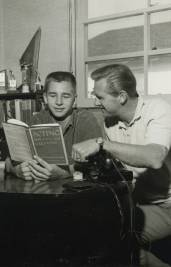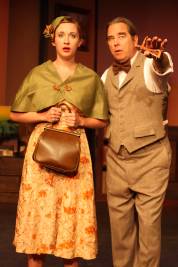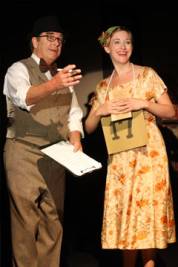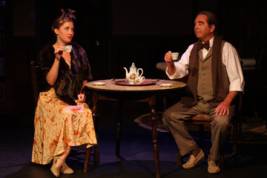
There’s an old black-and-white fan magazine snapshot of TV star Lloyd Bridges and his then teenage son Beau circa Sea Hunt. In the shot, Bridges Sr. and Bridges Jr. are reading a copy of Richard Boleslavsky’s 1933 guide to Acting: The First Six Lessons. Now, some fifty or so years later, 68-year-old Beau and his 23-year-old daughter Emily are staging Boleslavky’s classic text at Theatre West, and the result is an often enthralling and edifying hour and a half of theater, brought to life by a multi-award-winning actor at the peak of his gifts and a exciting young actress just beginning her journey.
Boleslavky’s book is written as a series of dialogs between two characters, the “Teacher” and the “Creature,” and under Charlie Mount’s imaginative direction makes a smooth transition to the stage, especially with mood-setting original music by David Loud and an extremely effective lighting design by Yancey Dunham.
The performance begins with Beau as himself, telling Bridges family anecdotes as Emily goes about setting the stage. (Director Mount and the two Bridges are credited with set decoration. The design itself, of a sort of multipurpose circa 1930s living era is based on an original design by Jeff Rack.) “Tell them about the book Dad,” Emily interrupts, and Beau proceeds to do just that. He informs us that it is the only book his dad ever gave him, and that he himself gave it to Emily when she was twelve (in 1998, the year of Lloyd Bridges’ death).
Following several Lloyd Bridges anecdotes, we flash back to 1933 and the height of the Great Depression. We are in the front room of the acting teacher’s apartment where he imparts his wisdom. Enter the “Creature,” who enthusiastically informs her teacher that all she wants to do in life is “Play! Play! Play!” Young as she is, she’s already done King Lear—in the title role, no less. He asks her to show him how she played the line “Blow, winds, and crack your cheeks! Rage! Blow!” and the result is god-awful. “Try saying it without ‘cursing the heavens,’” advises the Teacher, but try as she might the poor young thing can’t manage to say the words plainly and simply. “You’ve destroyed the very conception of the word ‘theater,’” accuses the Teacher. Worse still, when asked to define acting, the lovely but pathetic young creature is at a complete loss.
Fortunately, her teacher is there to set her straight. “Don’t start with a Chopin nocturne,” he advises. “Start with scales.” Good advice to both aspiring pianist and aspiring actor.
The six lessons are Concentration, Memory Of Emotions (She: “How can I play a murderer when I’ve never murdered anyone? He: “Why does everybody ask me about murders?!”), Dramatic Action, Characterization, Observation, and Rhythm.
There are laughs aplenty in Acting: The First Six Lessons, thanks especially to Bridges père and Bridges fille’s splendid performances. When Teacher asks Pupil to “Listen to the sound of an imaginary mouse in the corner,” Pupil can only reply, “Where’s the audience?” When Teacher explains that Pupil will need talent, technique, education, and training if she wants to call herself an actor, it’s simply too much for the young thing to process, and she runs away, as far away as possible. Later, when she returns, she’s completely out of breath, having nearly been run over because she was “concentrating on the happiness of my existence,” as Teacher had instructed her to do.
There’s an interesting segment on acting “for the talkies,” in which the Creature expresses her frustration at having to do short takes between constant interruptions, a dilemma which is as relevant today as it was during the first decade of sound motion pictures. Another segment talks about an actor’s need to be always spying on others and to learn from this eavesdropping.
Both Bridges double as other characters. The elder Bridges is a seen-it-all, done-it-all Stage Manager, who instructs Auditioner #17 (Emily) to “Let the character speak through you.” Emily has a great turn as the Creature’s aunt, out for tea with the Director, in which she informs him rather haughtily that she doesn’t believe at all in the exercises he’s giving her niece.
Over the course of ten scenes, the action moves from the Teacher’s studio to a small theater to a film set to Central park and back, and finally, to a moving denouement atop the Empire State Building in 1936.
Both Bridges are terrific, and it’s not every day that one gets to spend an hour or two with an actor with over six decades in the biz (Beau’s first screen appearance was at age six in No Minor Vices) who is a household name as well. The simple act of watching Beau Bridges’ facial reactions to his daughters’ lines is an education. The captivating Emily Bridges is an actress of considerable talent and great promise, whose role allows her to transition step by step from clueless newbie to accomplished vet. In one particularly memorable scene, she plays Ophelia quite movingly opposite an invisible Hamlet. Then, following suggestions by the Teacher which allow her to physically become Ophelia, she plays it again, even better the second time.
Each performance is followed by talkback with father and daughter, a treat in and of itself. At Opening Night’s talkback, an audience member remarked that she had learned more about acting that evening than she had in her entire MFA program. An exaggeration, perhaps, but a reflection of just how effective and affecting Acting: The First Six Lessons is.
Whether you are a student of acting, or simply a lover of good theater, Acting: The First Six Lessons has many tips to offer and many life lessons to bestow. With its big name star and broad intergenerational appeal, it is likely to be a big, big hit for Theatre West.
Theatre West, 3333 Cahuenga Blvd. West, Los Angeles.
www.theatrewest.org
–Steven Stanley
April 9, 2010
Photos: Thomas Mikusz






 Since 2007, Steven Stanley's StageSceneLA.com has spotlighted the best in Southern California theater via reviews, interviews, and its annual StageSceneLA Scenies.
Since 2007, Steven Stanley's StageSceneLA.com has spotlighted the best in Southern California theater via reviews, interviews, and its annual StageSceneLA Scenies.







 COPYRIGHT 2024 STEVEN STANLEY :: DESIGN BY
COPYRIGHT 2024 STEVEN STANLEY :: DESIGN BY